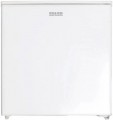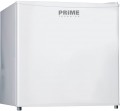Total capacity
The total capacity of the refrigerator is the total capacity of all the main working chambers: refrigerating, freezing, zero, and wine chambers. The set of these chambers, of course, will be different in different models (see more about them above). Here we note that large volumes, on the one hand, simplify the storage of numerous products and, on the other hand, affect the dimensions and price of the unit. It is also worth considering that refrigerators of the same total capacity may differ in the capacity of individual chambers.
Refrigerator capacity
The total capacity of the main working chamber of the refrigerator. If there are separate zero chambers, compartments for wine and other additional functions, this paragraph takes into account only the volume of the refrigerating chamber itself, without additional equipment. In the smallest modern units, this figure
does not even reach 100 liters, in the largest it can exceed
400 liters.
The choice of capacity depends on the actual storage needs of the products. At the same time, both the volume of stocks and the frequency of their replenishment (every day, once a week, etc.) matter. The chamber should not be stocked completely; this adversely affects the quality of the refrigerator. On the other hand, it is worth remembering that large volumes accordingly affect the dimensions and price of the unit.
In general, for one or two people, a capacity of
200 – 250 liters, or even less, is considered quite sufficient. The optimal capacity for a family of three is about
250 – 300 liters, for four to five people —
300 – 350 liters, and larger volumes are really needed mainly for specific situations when food has to be stored in large quantities and for a long time.
Energy class
Refrigerator energy class according to the old European standard valid until 2021.
The energy class shows how economical the unit is compared to other models with similar specifications. It is used for devices manufactured before March 1, 2021. Initially, in this standard, classes were designated in Latin letters from A (most economical) to G (high power consumption). However, later improved classes A+, A++, and others appeared. (the more pluses, the more effective is the device). For modern refrigerators, marking A according to the old system is actually the minimum level of energy efficiency specific for outdated and low-cost devices; most models are classified as
A + and
A ++, and most
A+++. There is no need to wait for more pluses. Since 2021, all new equipment will be marked according to the new system, where class G will correspond to the old class A, class F to class A+ and so on.
Note that a higher energy efficiency class (with similar specifications) means a higher price but this difference can quickly pay off due to energy savings.
Climate class
The climate class to which the refrigerator corresponds.
As the name implies, this parameter describes the environmental conditions for which the unit is designed. The warmer it is around — the more powerful the refrigerator should be and the better thermal insulation it should have. Specific classes are indicated by letters, here are the most popular options:
—
SN (subnormal). Models for a temperate cool climate, have an operating range from +10 °C to + 32 °C. Such a unit can be useful in a poorly heated room where the temperature can drop below +16 °C — for example, on the veranda of a private house, in a garage, etc.
—
N (normal). Refrigerators for temperate climates, with an operating temperature range of +16...+32 °C. Such a unit is suitable for most residential apartments and houses in mid-latitudes.
—
ST (subtropical). Models for subtropical and humid tropical climates. Normally work at the range of external temperatures +18...+38 °C.
—
T (tropical). Refrigerators for dry tropical climates. Designed for temperature range +18 °С to +43 °С.
There are many models on the market with an extended temperature range covering several classes. For example, a unit labelled N-ST will have a temperature range of +16...+38 °C. Such refrigerators are indispensable in complicated
...climates, the conditions of which are not covered by one standard class — for example, during cold winters and hot summers.Noise level
The average noise level generated by the refrigerator during operation.
The
quietest models of refrigerators are noisy at a level of about 30 dB — this volume is comparable to the whispering or ticking of a wall clock and does not exceed the sanitary standards for residential premises at night. In other words, such a unit will not interfere with sleep, even if it is placed right in the bedroom. At the same time, the standard place for a refrigerator is still a kitchen, and with such an installation it is isolated from other living quarters. Therefore, the noise of 40 – 42 dB, corresponding to a quiet conversation, is considered quite acceptable for ordinary household refrigerators. And with good sound insulation, a volume of up to 50 dB is allowed — this is the level of conversation at an average volume.
Higher values are rare among refrigerators and are mainly found in display refrigerators(see "Product type") installed in shops where noise levels are not as much important.
Country of origin
The country in which this refrigerator model is manufactured (according to the manufacturer).
There are many stereotypes associated with the relationship between the origin and the quality of household appliances. Thus, the location of production in Europe (
Germany,
Lithuania,
Poland,
Romania,
Serbia,
Turkey, etc.) is considered more prestigious than in Asian countries (
China,
Thailand) or CIS countries (
Belarus,
Russia, Uzbekistan, etc.). And different European countries have a different reputation among buyers in this regard. However, these stereotypes should be treated with considerable distrust: the actual quality of products depends not so much on the geography of production, but on the quality of the organization of processes by a particular manufacturer. As a result, equipment of a similar level, produced by different brands in the same country, may differ markedly in actual quality.
It is worth to say that the same refrigerator model can be produced in several countries at the same time. And units of the same model, produced at different times at different plants, may be on the market at the same time. As a re
...sult, it happens that one country of production is indicated in the general characteristics of the model and another in the documentation for the unit purchased. It is quite a normal situation. However, if the country of production is still important for you, you should clarify this point in advance before buying.
